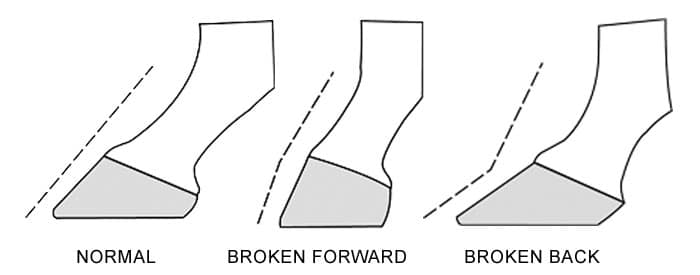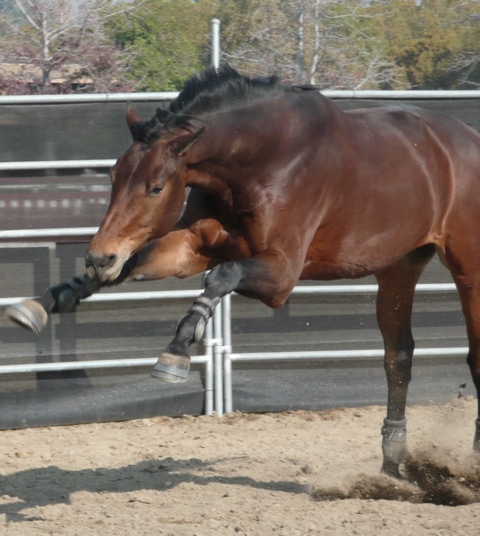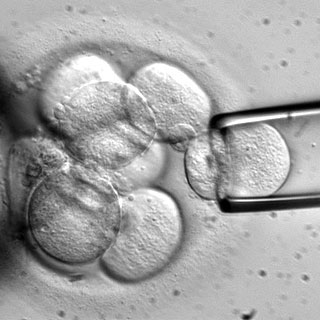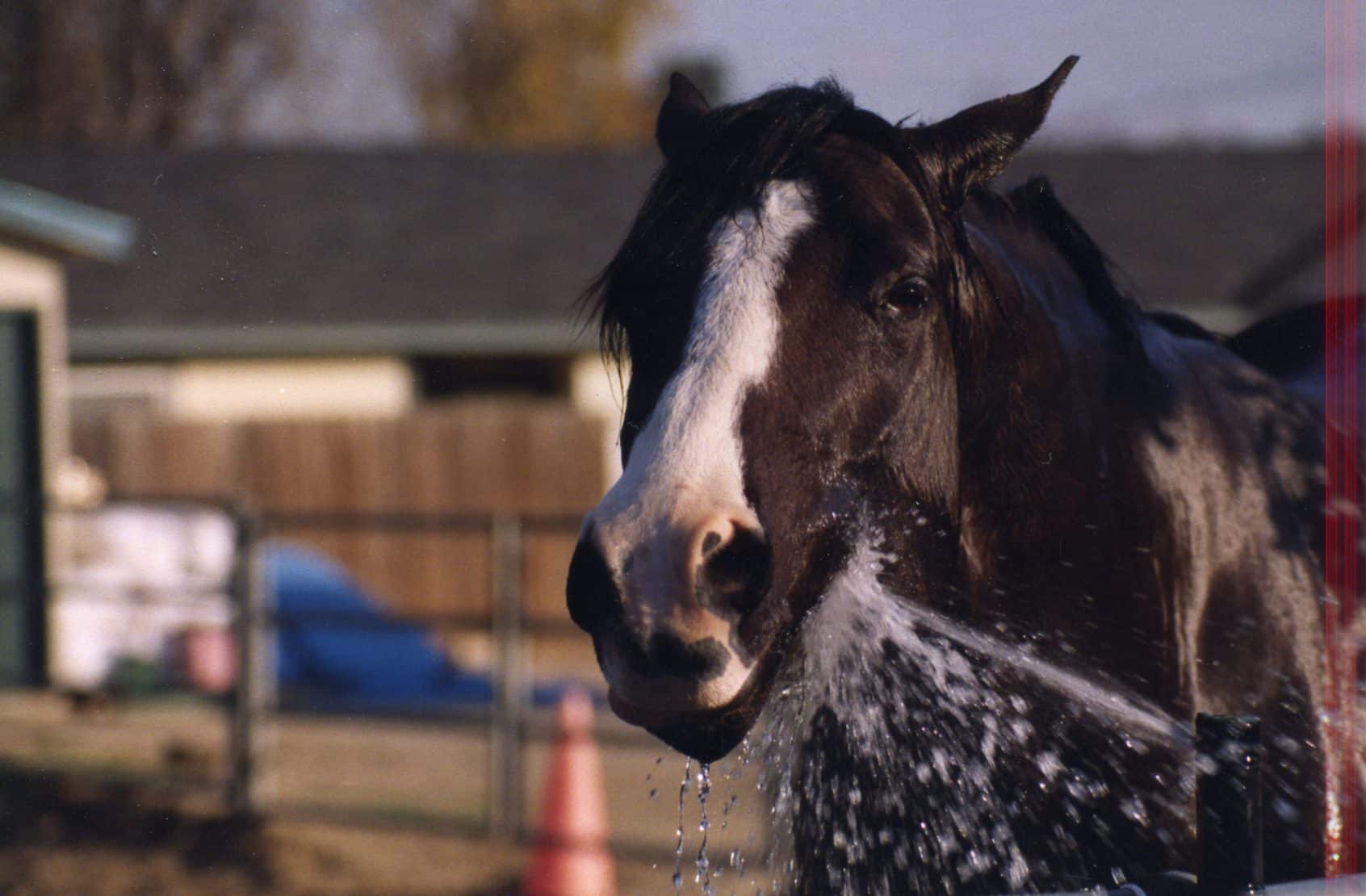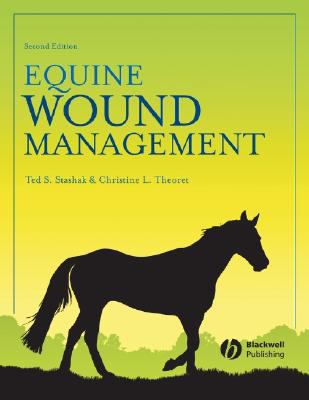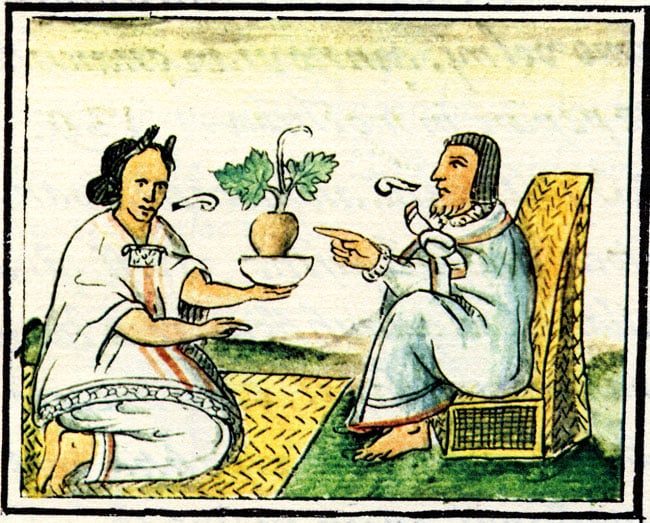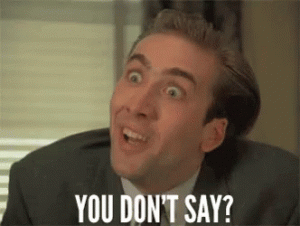 One of the truisms of equine musculoskeletal health is the time-honored statement, “No hoof, no horse.” While pretty much agrees with this old adage, there are still many, many opinions about the horse’s hoof, and the best way to take care of it. That is, in spite of the fact that pretty much everyone is in agreement that the horse’s hoof is important, there’s a lot of disagreement about the particulars.
One of the truisms of equine musculoskeletal health is the time-honored statement, “No hoof, no horse.” While pretty much agrees with this old adage, there are still many, many opinions about the horse’s hoof, and the best way to take care of it. That is, in spite of the fact that pretty much everyone is in agreement that the horse’s hoof is important, there’s a lot of disagreement about the particulars.
One area that pretty much everyone agrees is a problem is low heels and long toes. Most articles and research have been done evaluating things that are done to the hooves on the horse’s front legs, however, as it turns out, horses have hooves on the hind limbs, too. Thus, it’s interesting to see that a bit more attention has been recently paid to the oft-neglected hind feet of the horse.
While it is fairly well-established that low heels, long toes, and the angle of the horse’s coffin bone are associated with injuries to the front legs, the heels of the hind legs haven’t been looked at much at all, research-wise. However, in 2019, there were two papers that suggested that abnormalities of the heels of the hooves of the hind legs were significantly associated with hind limb lameness (CLICK HERE and CLICK HERE to see the studies).
THE PROBLEM
 If you tell someone that your horse’s hooves need to be balanced, you will find pretty much no one to disagree with around the barn (which, frankly, is a bit of an accomplishment, at least in some barns). Even so, what with the devil being in the details, it can be pretty hard to get everyone to agree on what the ideal balance is, what with trying to measure it from front-to-back and side-to-side and all. Still, things like balance, the way that the horse’s hoof and legs work (the “mechanics,” as it were), as well as the various reactions that the horse’s hooves have with the ground are all very important when it comes to keeping the horse’s hoof healthy. They’re important in performance, too.
If you tell someone that your horse’s hooves need to be balanced, you will find pretty much no one to disagree with around the barn (which, frankly, is a bit of an accomplishment, at least in some barns). Even so, what with the devil being in the details, it can be pretty hard to get everyone to agree on what the ideal balance is, what with trying to measure it from front-to-back and side-to-side and all. Still, things like balance, the way that the horse’s hoof and legs work (the “mechanics,” as it were), as well as the various reactions that the horse’s hooves have with the ground are all very important when it comes to keeping the horse’s hoof healthy. They’re important in performance, too.
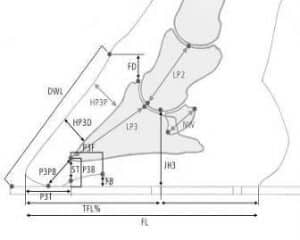
Simple measurements anyone can do at home
Some folks have gone so far as to take measurements of all of this stuff, because, well, that’s how some people are. So, for example, “Ideal” hoof mechanics are theorized to occur when the hoof-pastern axis, that is, alignment between the hoof and pastern angles, is straight (you can see a straight line running down the front of the pastern, down the hoof, and to the ground). It has also been asserted that the angle between the ground and the bottom of the coffin bone (also known as the third phalanx, or P3), should be around 5 degrees.
QUICK HISTORICAL ASIDE: Did you know that it’s called the “coffin bone” because, as stated in an 18-century veterinary text that I have, the bone is contained within the hoof as a body is contained in a coffin? Morbid, perhaps, but there you go.
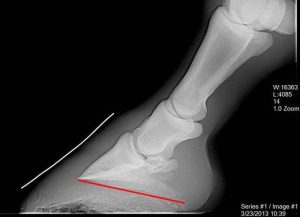
A reverse palmar angle
Anyway, when the angle between the ground and the bottom of the coffin bone is negative (some people may call it “reverse rotation” or “negative palmar angle”), it’s said that abnormal forces may be placed on the horse’s foot and limb. Think of it as if you were standing on the edge of the stairs, with only your toes on the stairs. Your heels would sink, and, frankly, you’d get a nice calf stretch, but if you overdid it, or did it for too long, you could hurt yourself. In that same way, the negative angle of the coffin bone is theorized to cause all sorts of limb problems. For example, in the front legs, it has been shown that a negative angle of the coffin bone increases the forces applied to the navicular bone. A long-toe, low-heel hoof conformation with the negative coffin bone angle has also been associated with catastrophic breakdown injuries in the forelimb suspensory ligament.
Otherwise stated, pretty much everyone agrees that very low heels are bad for a horse. No matter if they are on front or hind limbs.
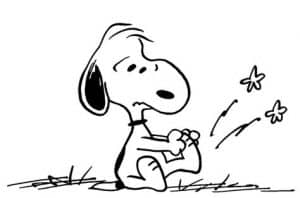 The low heel/long toe thing is most likely the most common abnormality of the horse’s hind feet, too. However, given that most horse lameness problems are in the front legs, the fact that horses tend to suffer different injuries in the hind legs than in the front legs, and that the horse carries most of his weight in the front legs, the hind feet have been pretty much overlooked, in terms of receiving much scientific study.
The low heel/long toe thing is most likely the most common abnormality of the horse’s hind feet, too. However, given that most horse lameness problems are in the front legs, the fact that horses tend to suffer different injuries in the hind legs than in the front legs, and that the horse carries most of his weight in the front legs, the hind feet have been pretty much overlooked, in terms of receiving much scientific study.
Nevertheless, there have been a few scientific tidbits. These studies mostly showed that doing things to the hind feet affected the horse’s hind legs. For example, in 1990, it was reported that a low heel/long toe conformation made it take a bit longer for the hoof to roll over the toe; this, at least theoretically, could increase strain on the structures inside the hoof and along the back part of the hind leg: think about how stretching off the stairs would feel, if you overdid it. In 2006, investigators showed that if you put wedges under the heels, it would also change the angles of the lowest three joints in the hind limb at the walk and trot (this had previously been shown in the fore limbs of standing horses). But that was pretty much it. Until 2019.
RECENT INVESTIGATIONS
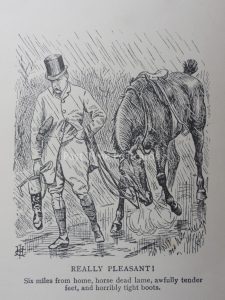 In 2019, two different groups of investigators reported that low heels, and a negative angle in the heels, were associated with hind limb lameness. The studies concluded that different joints were primarily affected, but that’s only a minor annoyance (at least in my opinion). The first study was done in Western performance horses. They found that when they compared the 80 studied horses to 80 other horses (the controls), horses with lameness that could be localized to the lower hock joints – but not the stifle – were more likely to have negative or neutral angles. They could not say that the lower heels caused the lameness, just that if the horse was lame in the lower hock joints, it was more likely to have low heels/negative angles.
In 2019, two different groups of investigators reported that low heels, and a negative angle in the heels, were associated with hind limb lameness. The studies concluded that different joints were primarily affected, but that’s only a minor annoyance (at least in my opinion). The first study was done in Western performance horses. They found that when they compared the 80 studied horses to 80 other horses (the controls), horses with lameness that could be localized to the lower hock joints – but not the stifle – were more likely to have negative or neutral angles. They could not say that the lower heels caused the lameness, just that if the horse was lame in the lower hock joints, it was more likely to have low heels/negative angles.
The second study was done in the UK. They looked at 132 horses with hind leg lameness and found that the most frequent sites of lameness in these horses was the stifle (59%), followed by the distal tarsal joints, and the proximal suspensory ligament area (that is, the part that’s closest to the hock). The authors of this study concluded that low heels were associated with hind limb lameness, including stifle lameness. Perhaps the fact that stifles were associated with low heels was just the fact that the studies were looking at different populations of horses – I mean, it is a good distance from the western United States to the UK, and the climates are almost exactly unlike each other.
TAKE HOME MESSAGE
You can’t say that low heels in the hind feet cause horses to injure themselves based on these studies. However, you’d certainly be well within reason to conclude that if you’re looking at a horse who has problems in his hind legs, you shouldn’t forget about the feet. You can do a reasonably good job assessing balance just by looking at the horse’s legs, and you can always ask your veterinarian to work with your farrier, X-ray the feet, and to work together to try to make sure that the feet are balanced (there’s a concept). If a horse is performing poorly, or if he’s lame behind, even if the hoof isn’t the primary problem, it’s still something that might need to be addressed. That, “No hoof, no horse” thing is always something to keep in mind, no matter which set of legs you’re looking at.
